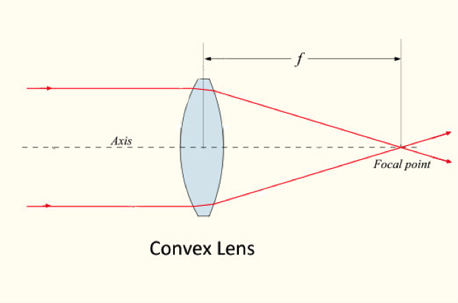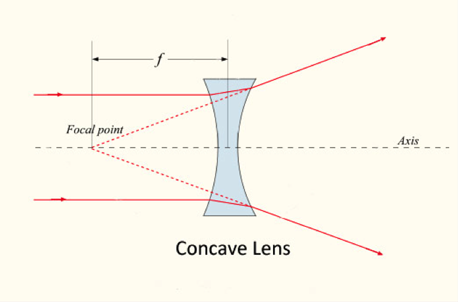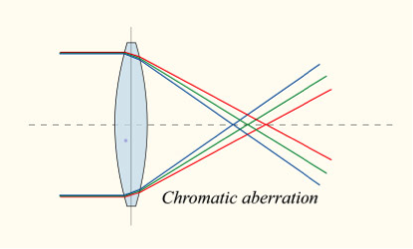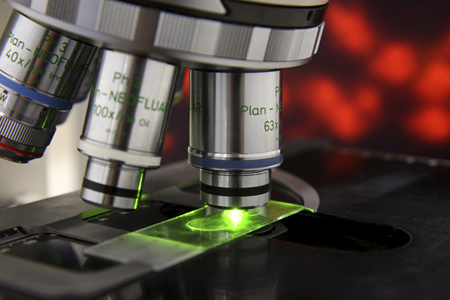-
WHAT IS NASA PHYSICS?
-
MODULES
-
Forces and Motion
-
Conservation of Momentum & Energy
-
Temperature and Heat
-
Fluids
-
Optics
-
Electromagnetic Spectrum
-
Modern Physics
-
Anticipation Guide 7
-
Intro to Modern Physics
-
Blackbody Radiation
-
The Ultraviolet Catastrophe
-
The Photoelectric Effect
-
Bohr's Atom
-
Spectra
-
Radioactive Decay
-
Special Relativity (SR)
-
Simultaneity
-
Distance and Time
-
General Relativity
-
May the Forces be with You
-
Modern Physics Notebook
-
Assessment Problems 7
-
-
Useful Things
-
-
SITE MAP
Optics
Lenses
Convex Lenses
 Parallel light rays coming from the left are refracted by a convex lens to come to a focus a distance f (the focal length) beyond the lens. Image modified from Wikipedia.In 13th century Italy someone invented spectacles to improve vision. The ability to make lenses led to many additional uses of lenses – including over time for microscopes, telescopes, cameras and even lighthouse lamps. The invention of eyeglasses transformed the lives of older people, whose eyes often lose the ability to focus with age. Wait, it will happen to you when you reach about 40 years old.
Parallel light rays coming from the left are refracted by a convex lens to come to a focus a distance f (the focal length) beyond the lens. Image modified from Wikipedia.In 13th century Italy someone invented spectacles to improve vision. The ability to make lenses led to many additional uses of lenses – including over time for microscopes, telescopes, cameras and even lighthouse lamps. The invention of eyeglasses transformed the lives of older people, whose eyes often lose the ability to focus with age. Wait, it will happen to you when you reach about 40 years old.
A lens is a specially shaped piece of glass that bends light to magnify objects, or to correct a defect in the viewer’s eye so the object can be seen clearly. Most lenses are convex, which means they are thick in the middle and thinner around the edges. This shape causes a controlled refracting that brings light to a convergence at the focal point of the lens. The distance from the lens to the focal point is called the focal length. The focal length determines the magnification of a lens.
Images formed by a lens are upside down. In binoculars, additional optical elements are used to turn the image right side up.

Concave Lenses
 Parallel light rays coming from the left are diverged by a concave lens so that they seem to come from a point closer to the lens. Image modified from Wikipedia.Concave lenses are the opposite of convex - they are thick around the edges and thin in the center. Such concave or diverging lenses don’t bring light to a focus, but change the angle of the rays so it appears that the object being imaged is closer than it really is; concave lenses make things look smaller.
Parallel light rays coming from the left are diverged by a concave lens so that they seem to come from a point closer to the lens. Image modified from Wikipedia.Concave lenses are the opposite of convex - they are thick around the edges and thin in the center. Such concave or diverging lenses don’t bring light to a focus, but change the angle of the rays so it appears that the object being imaged is closer than it really is; concave lenses make things look smaller.
Why would anyone use a concave lens? When a simple convex lens brings light to a focus each wavelength of light is bent a different amount and hence not all colors focus at exactly the same point. This spreads the red and blue apart, making the image not completely focused. This is called chromatic aberration – color deviation.
By placing a convex and a concave lens together, each with a somewhat different index of refraction, most colors can be brought to better focus. All refractor telescopes and microscopes use two or even three lens to reduce the unwanted color caused. Two lens glued together are called an achromatic doublet – achromatic means no color, and doublet means two lenses together.


Images from Wikipedia.
Microscopes
Microscopes magnify objects that are relatively close – the opposite challenge of telescopes. The lower lens near the sample is called the objective and has a very short focal length, making the image appear quite large. The upper lens is called the eyepiece. This lens focuses on the image created by the objective lens and magnifies it. The final magnification of the sample is found by multiplying together the magnification caused by each of the two lenses. 

Some microscopes have double eyepieces that allow two people to see the same image simultaneously. Many microscopes can be attached directly to video cameras, which connect to computers monitors for whole class viewing or video recording.
Most microscopes, such as in the photo, have multiple objective lenses to provide different magnifications.
Object
Image
© 2013 by Wheeling Jesuit University/Center for Educational Technologies®. 316 Washington Ave., Wheeling, WV 26003-6243. All rights reserved. Privacy Policy and Terms of Use.

